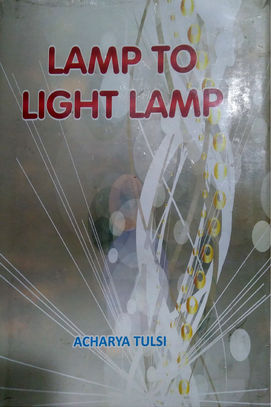Some people talk these days about an international world order, world religion, universal good, world development and global thinking. Some people are completely self-centred. Far from thinking about the world, they are not willing to think in terms of their country, society, town, neighbourhood or even family. It is my view that man's thinking should be guided by an attitude of non-absolutism (anekantvada). If we think about the individual and the world, we must regard them in relative terms. The world cannot be made by disregarding the individual, and without the world, the identity of the individual cannot be established. Bricks are used for the construction of a building. But what purpose would the bricks serve by themselves? Other building materials are also required along with the bricks. Similarly, an all round development is possible only with the appropriate development of both the individual and the society.
The individual is included in the world.The individual cannot be alone, cannot live alone. In that case, the appropriate thing would be to begin the thinking process from the individual and extend it to the world. The plate is laden with food. But the food in the plate cannot be eaten all at once. If a person uses his discretion, then he can eat his stomach full.
Once Chanakya went to the house of an old woman. He was hungry. The old woman served him a plateful of khichri. Chankya put his hand m the centre. His fingers got scalded. The old woman had not recognised Chanakya. Taking him to be an ordinary wayfarer she remarked "You are stupid like Chanakya." Chanakya was taken aback. He asked, "Mother, what was Chankya's stupidity?" The old woman replied, "He went and attacked Pataliputra without conquering the surrounding small kingdoms. That is why he had to face defeat. You too would not have scalded your hand if you had started eating khichri little by little from the outer edge. What was the sense in putting your fingers in the centre?”
The idea of world religion is also not wrong. But it is necessary to understand its true form. Religion has two aspects—worship and conduct. Any religion centred round worship can never become a world religion. Because of different faiths and inclinations, there can be differences of worship too. Whereas it is possible to have an all round agreement about conduct. Shaping life and shaping the character are some of the matters which are uniformly applicable to the entire world. If they are linked together and presented in the form of a religion without attributes, then a kind of world-religion can emerge. If that religion has got to be qualified with some attributes, it may be called the human religion. Friendliness, self-restraint and non-violence are all elements of code of conduct, about which how can there be any difference in terms of belief, faith, sanskara or idea? All people are concerned with these elements. A person may or may not believe in religion, but he cannot disregard friendliness and such other elements. If that is the case, then the idea of world-religion can easily become a reality.
What is the difference between the individual and the world? The individual is the yarn and the world is the (woven) cloth. The individual is the bead and the world is the necklace. Both are linked together. Nonetheless, before weaving the cloth, the quality of the yarn has to be looked into. Even in the presumed idea of the world-religion, it is fundamentally necessary to catch hold of the individual. If every individual becomes religious or spiritual, irreligion would have no ground to persist. In my opinion, the principles of anuvrat are such that they can be established in the form of world-religion In the course of my long padayatras and widespread contacts with the public, I have not come across a single person, who had rejected anuvrat in principle Hence it can be expected today that the background for the world-religion be prepared by making every individual of good conduct or religious-minded.
 Acharya Tulsi
Acharya Tulsi
